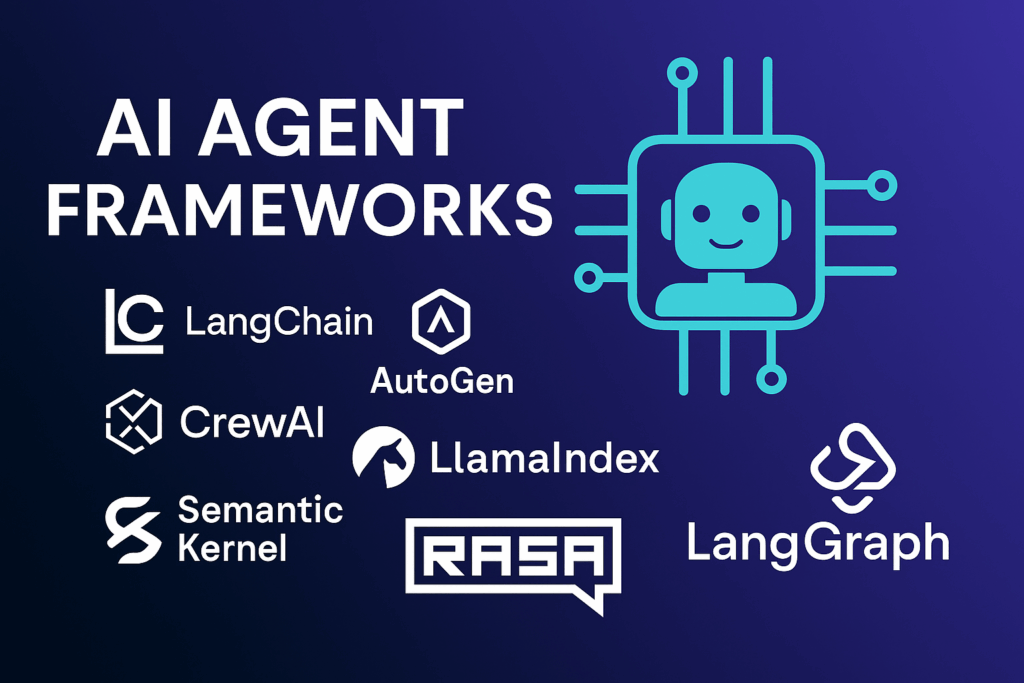
AI Agents are on the rise. They automate processes, understand complex tasks, and communicate naturally with users. But to build such agents efficiently, you need the right foundation: AI-Agent Frameworks.
In this article, you’ll learn which AI Agent Frameworks are currently available, what they can do, how they differ, and how to choose the right framework for your use case.
You can watch also this articel as a video:
What Are AI Agent Frameworks?
An AI Agent Framework is a set of tools, interfaces, and design principles that help you efficiently develop and orchestrate intelligent agents. Whether it’s about extracting information from text, interacting with APIs, or managing workflows across multiple tools – frameworks give you structure and reusability.
The Most Popular AI Agent Frameworks Compared
1. LangChain
Pros:
- Actively maintained & large community
- Excellent documentation
- Integrates with OpenAI, Pinecone, FAISS, HuggingFace, and more
- Many templates and tools for Retrieval Augmented Generation (RAG)
Cons:
- High complexity for beginners
- Depends on external infrastructure
Use cases: Chatbots, Q&A systems, knowledge bases
2. AutoGen (Microsoft)
Pros:
- Focus on multi-agent systems
- Good Azure integration
- Agents communicate autonomously
Cons:
- Azure-centric
- Smaller community
Use cases: Research, autonomous workflows, complex automation tasks
3. CrewAI
Pros:
- Lightweight framework
- Focus on agent collaboration
- Great for team-based AI tasks
Cons:
- Relatively new
- Limited documentation & examples
Use cases: Cooperative AI processes (e.g., product development, content creation)
4. LlamaIndex (formerly GPT Index)
Pros:
- Focus on indexing & RAG
- Extremely flexible with data sources (CSV, PDF, Notion, etc.)
- Can be combined with LangChain
Cons:
- Less focused on multi-agent interaction
Use cases: Knowledge bases, intranet search, AI assistants with internal documentation
5. Semantic Kernel (Microsoft)
Pros:
- Clear structure with Skills, Memories, Planner
- Excellent .NET integration
- Cross-platform support
Cons:
- Limited usability outside Microsoft environments
Use cases: Internal enterprise agents, MS365 automation
6. Rasa (Open Source)
Pros:
- Fully self-hostable
- NLP-based (not only LLMs)
- GDPR-compliant & popular in the EU
Cons:
- More focused on traditional bots than LLMs
- Heavier setup
Use cases: Customer support, voice bots, chatbots with dialog control
7. LangGraph
Pros:
- State-based flows with graph logic
- Ideal for multi-step conversations & processes
- State management with memory
Cons:
- Still under development
- Fewer resources than LangChain
Use cases: Complex conversation flows, agents with memory
How to Choose the Right AI Agent Framework
Here are the most important criteria to consider:
1. Purpose of the Agent
- Want to process invoices? LlamaIndex or LangChain with RAG is enough.
- Want to manage sales avatars? CrewAI or AutoGen is ideal.
2. Complexity
- For simple use cases: LangChain, LlamaIndex
- For agent teams: CrewAI, AutoGen, LangGraph
3. Hosting & Data Privacy
- GDPR a priority? Use Rasa or self-hosted LangChain
4. Tech Stack Integration
- .NET? Go with Semantic Kernel
- Python? Almost everything
- Using Power Automate? Prefer SK or AutoGen
5. Community & Support
- For beginners: LangChain (thanks to its large community)
- For tinkerers: CrewAI, LangGraph
Conclusion: AI Agent Frameworks Unlock Full Potential
With the right framework, you can develop your AI Agent faster, with better structure, and deeper integration into existing systems. You don’t have to start from scratch – leverage the power of open source (and Microsoft).
If you’re unsure which framework fits your use case – feel free to contact me. I’m happy to support you with onboarding and strategic decisions.





Leave a Reply